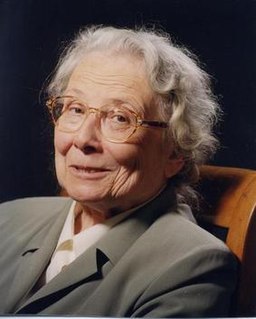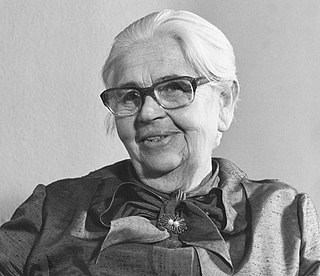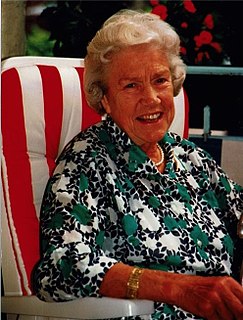Related Research Articles

Gustav Heinrich Johann Apollon Tammann was a prominent Baltic German chemist-physicist who made important contributions in the fields of glassy and solid solutions, heterogeneous equilibria, crystallization, and metallurgy.
Alfred Rieche was a German chemist.

Margarethe Mathilde von Wrangell, after 1928 Princess Andronikow, néeBaroness von Wrangell was a Baltic German agricultural chemist and the first female full professor at a German university.
Werner Kern was a German chemist.

The German Chemical Society is a learned society and professional association founded in 1949 to represent the interests of German chemists in local, national and international contexts. GDCh "brings together people working in chemistry and the molecular sciences and supports their striving for positive, sustainable scientific advance – for the good of humankind and the environment, and a future worth living for."
The Bohn–Schmidt reaction, a named reaction in chemistry, introduces a hydroxy group at an anthraquinone system. The anthraquinone must already have at least one hydroxy group. The reaction was first described in 1889 by René Bohn (1862–1922) and in 1891 by Robert Emanuel Schmidt (1864–1938), two German industrial chemists.
Martin Kaltschmitt is a German engineer and professor at Hamburg University of Technology. He is head of the Institute of Environmental technology and Energy economics at Hamburg University of Technology.
Werner Zerweck was a German chemist, inventor and industrial leader, who served as CEO of the chemical and pharmaceutical company Cassella from 1953 to 1963. Under his leadership the company focused increasingly on pharmaceuticals and cosmetics rather than its former primary focus, dyes. He was also a member of the advisory board of Deutsche Bank from 1953. Zerweck was one of the pioneers in the development of synthetic fibers.

Margot Becke-Goehring was a Professor of Inorganic Chemistry at the University of Heidelberg and she was the first female rector of a university in West Germany - the Heidelberg University. She was also the director of the Gmelin Institute of Inorganic Chemistry of the Max Planck Society that edited the Gmelins Handbuch der anorganischen Chemie. She studied Chemistry in Halle (Saale) and Munich, and she finished her doctorate and habilitation at the University of Halle. For her research on the chemistry of main-group elements, she was awarded Alfred Stock Memorial Prize. One of her most notable contributions to inorganic chemistry was her work on the synthesis and structure of poly(sulfur nitride), which was later discovered to be the first non-metallic superconductor. For her success in editing the Gmelins Handbuch der anorganischen Chemie, she received the Gmelin-Beilstein memorial coin.
Karl Wieghardt is a German inorganic chemist and emeritus director of the Max Planck Institute for Chemical Energy Conversion in Mülheim. He was active in the preparation and detailed characterization of models for iron and manganese metalloenzymes, metal complexes of noninnocent ligands, and magnetic interactions in polynuclear metal complexes.
Marianne Baudler was a German chemist. She is known for her research on phosphorus.

Edith Weyde was a German chemist. She developed the silver salt Diffusion transfer—"Copyrapid"—which paved the way for the first photocopiers and instant photography. She also laid the foundation for color photography.

Brigitte Sarry was a German chemist and a professor at the Technical University of Berlin.
Hildegard Hess was a German chemist. She was the first woman to become a Handelschemiker and to direct an independent testing laboratory in Berlin, if not in all of Germany.

Luise Holzapfel was a German chemist and later head of department of the Kaiser Wilhelm/Max Planck Institute for Silicate Research. She is known for her research on silicosis.
Clara von Simson was a habilitated natural scientist, German politician (FDP) and a member of the Berlin House of Representatives.
Brigitte Eisenmann was a German chemist and a professor at the Technische Universität Darmstadt. She was the first woman professor for Chemistry at the Technische Universität Darmstadt. Together with Herbert Schäfer, she extended the definition of Zintl phases.
Sibylle Kemmler-Sack was a German chemist. She was a professor for Chemistry at the University of Tübingen.
Emma Maria Wolffhardt was a German Industrial Chemist at BASF and she was the first women chemist at BASF who had her own research area. Furthermore, she was the first to use the carlotte model for understanding and improving organic synthesis.

Heinrich August Bernthsen was a German chemist who was among the first to synthesize and study the structures of methylene blue and phenothiazine.
References
- 1 2 3 4 5 6 7 "Chemikerinnen" (PDF). www.gdch.de. Retrieved 2019-01-12.
- 1 2 3 Schwarzl, Sonja M.; Hertel, Marion (2002). "Zum Beispiel: Liselotte Feikes". Nachrichten aus der Chemie (in German). 50 (5): 639–640. doi:10.1002/nadc.20020500532. ISSN 1868-0054.
- ↑ "Gesellschaft Deutscher Chemiker - Neuanmeldungen". Nachrichten aus Chemie und Technik. 1 (8): 65–68. 1953. doi:10.1002/nadc.19530010812. ISSN 1868-0054.
- ↑ "Jahrespreis". VGCT - Verein für Gerberei-Chemie und -Technik e.V. (in German). Retrieved 2019-01-19.
- ↑ "Ehrenmitglieder | VÖLT". www.voelt-rosensteingasse.at. Retrieved 2019-01-19.
- ↑ "Our Rich History – ALCA" . Retrieved 2019-01-19.